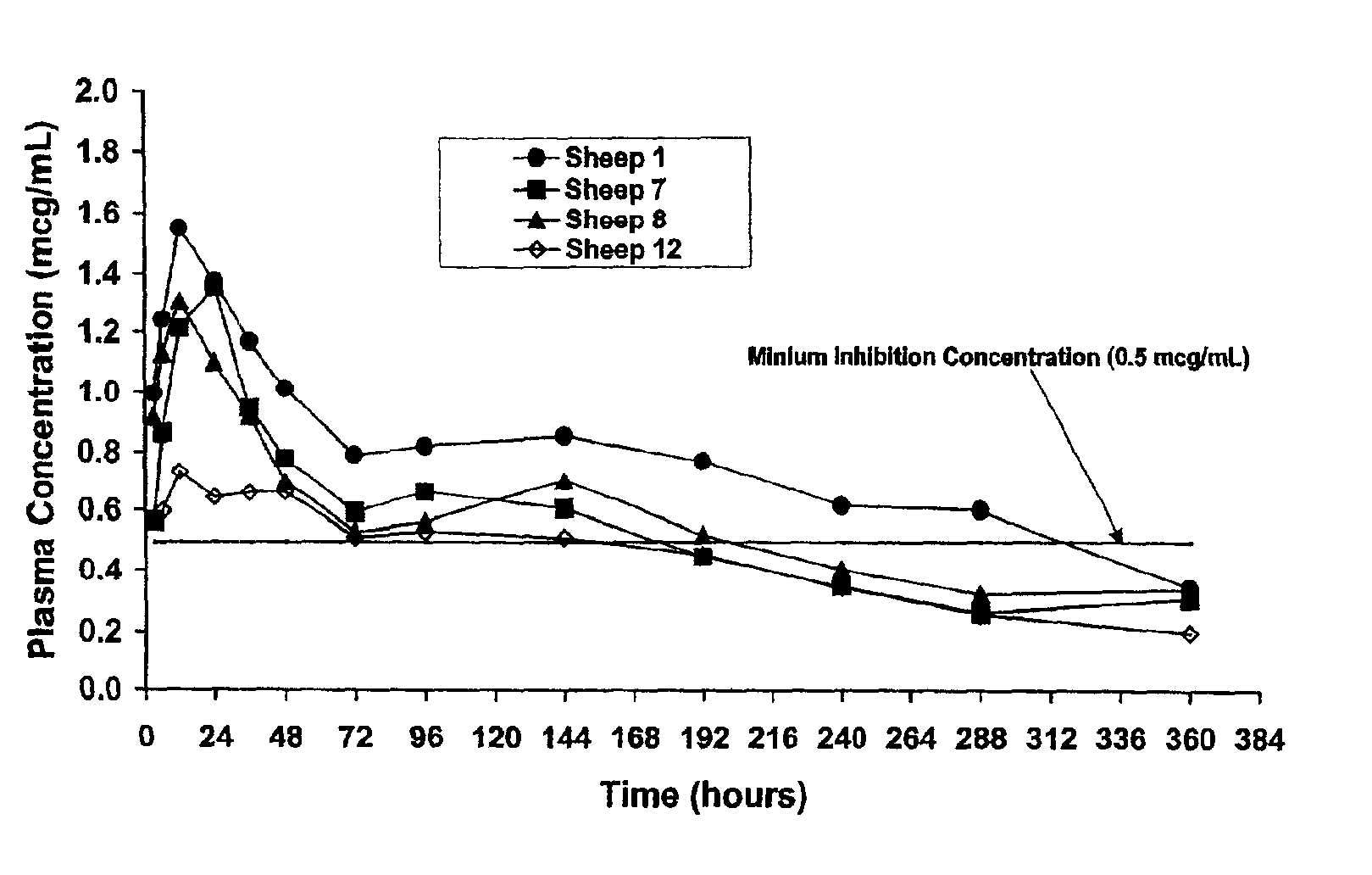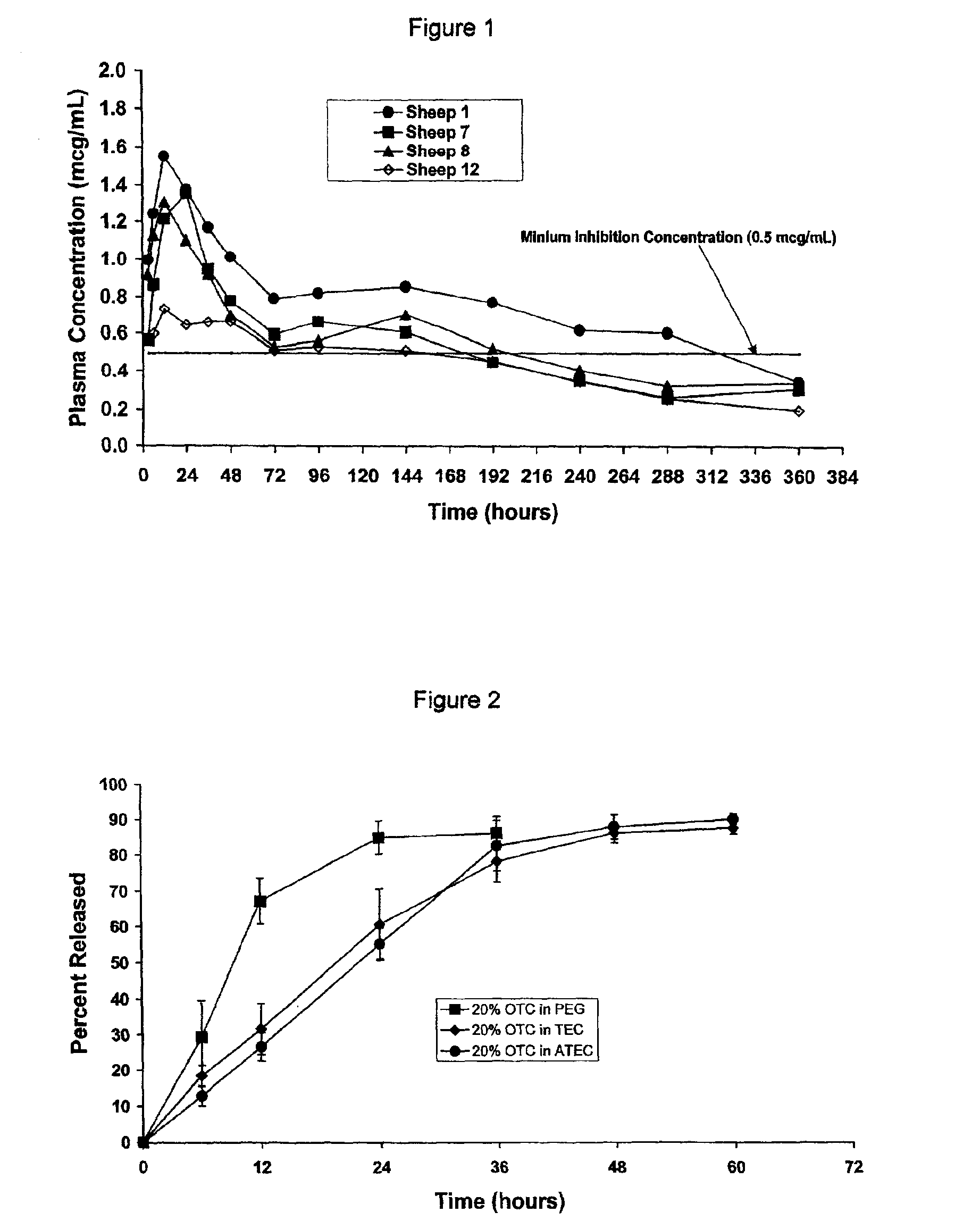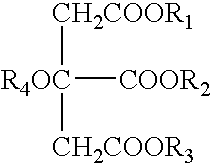Vehicles for delivery of biologically active substances
a biologically active substance and vehicle technology, applied in the direction of biocide, prosthesis, eye treatment, etc., can solve the problems of undiluted bas, unsuitable for controlled bas delivery, and other prior art vehicles that fail to provide the essential and ideal characteristics of a vehicle, so as to achieve physical and chemical stability, not compromise the stability of bas
- Summary
- Abstract
- Description
- Claims
- Application Information
AI Technical Summary
Benefits of technology
Problems solved by technology
Method used
Image
Examples
example 1
[0051]A pharmaceutical formulation containing 20% oxytetracycline (OTC) suspended in a vehicle of acetyl triethyl citrate (ATEC) was injected subcutaneously into 4 adult sheep. The minimum inhibitory concentration of OTC has been previously determined to be 0.5 mcg / ml. Blood samples were obtained from each of the four sheep at 3, 6, 12, 24, 36, 48 hours day 3, day 4, day 6, day 8 day 10, and day 15 after subcutaneous injection. Plasma concentrations of OTC were determined by an HPLC method.
[0052]As shown in FIG. 1, following the single injection of OTC in ATEC, the plasma concentration of OTC in each sheep peaked at about 12 hours following injection and then declined. The plasma concentration of OTC in each of the four sheep remained above the minimum inhibitory concentration for at least 6 days in each of the sheep, and in two of the four sheep remained above the minimum inhibitory concentration for 192 hours (8 days). In one of the sheep, the plasma concentration of OTC in ATEC r...
example 2
[0053]Appropriate quantities of oxytetracycline (OTC) were blended with either polyethylene glycol (PEG), triethyl citrate (TEC), or acetyl triethyl citrate (ATEC) to yield formulations with 20% OTC. The release of OTC from these formulations was evaluated in pH 7.4 phosphate buffer at 37° C. The cumulative percentage of OTC released from the formulations was determined at 6 and 12 hours, and each 12 hours thereafter until 60 hours (2.5 days). As shown in FIG. 2, release of OTC from the PEG vehicle was more rapid at all time points up to 36 hours. At 12 hours, almost 70% of the OTC had been released by the PEG vehicle, whereas about 30% or less had been released from each of the two citrate vehicles.
[0054]This Example illustrates how the release characteristics of a BAS may be altered by using vehicles that differ in their hydrophilicity. PEG 400 (Log P value of −1.44) is more hydrophilic than TEC (Log P value of 1.54) and ATEC (Log P value of 3.77). PEG 400 is also freely miscible ...
PUM
| Property | Measurement | Unit |
|---|---|---|
| Fraction | aaaaa | aaaaa |
| Fraction | aaaaa | aaaaa |
| Fraction | aaaaa | aaaaa |
Abstract
Description
Claims
Application Information
 Login to View More
Login to View More - R&D
- Intellectual Property
- Life Sciences
- Materials
- Tech Scout
- Unparalleled Data Quality
- Higher Quality Content
- 60% Fewer Hallucinations
Browse by: Latest US Patents, China's latest patents, Technical Efficacy Thesaurus, Application Domain, Technology Topic, Popular Technical Reports.
© 2025 PatSnap. All rights reserved.Legal|Privacy policy|Modern Slavery Act Transparency Statement|Sitemap|About US| Contact US: help@patsnap.com



